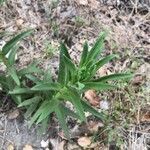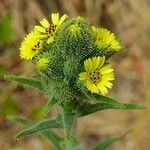Plants (0.3–)35–100(–240) cm, self-compatible (heads not showy). Stems hirsute and glandular-pubescent, glands yellowish, purple, or black, lateral branches rarely surpassing main stems. Leaf blades broadly lanceolate to linear-oblong or linear, 2–18 cm × 3–18(–29) mm. Heads in usually crowded, paniculiform, racemiform, or spiciform arrays. Involucres ovoid to urceolate, 6–16 mm. Phyllaries hirsute and glandular-pubescent, glands yellowish, purple, or black, apices erect or ± reflexed, flat. Paleae mostly persistent, connate 1/2+ their lengths. Ray florets (5–)8–13; corollas greenish yellow or sometimes purplish red abaxially or throughout, laminae 1.5–4 mm. Disc florets 11–14, bisexual, fertile; corollas 2–5 mm, pubescent; anthers ± dark purple. Ray cypselae black or brown, sometimes mottled, dull, compressed, beakless. Disc cypselae similar. 2n = 32.
Herb to 120 cm high. Stems with copious sticky glandular hairs. Leaves linear to lanceolate, sessile, 20–130 mm long, 4–12 mm wide, entire, acute, with sparse to dense glandular hairs. Capitula terminal or axillary, in dense clusters, 5–10 mm diam. at anthesis; involucral bracts 6–9, elliptic, 7–9 mm long, with blunt apex, folded around ray florets; receptacle scales strongly fused into a cup. Ray florets 6–9. Disc florets 7–14, bisexual; corolla tube 1.7–2.8 mm long, with dense eglandular hairs; lobes deltate to lanceolate, 0.2–0.4 mm long, glabrous; anthers c. 0.8 mm long. Achenes 3.5–5 mm long, brown to black; beak absent.
Coarse annual 2–10 dm, often simple, conspicuously spreading-hirsute and stipitate-glandular; lvs mostly lance-linear or linear-oblong, the lower linear-oblanceolate, 4–18 cm × 4–12 mm, entire or nearly so, sessile, crowded, erect; heads clustered along the upper part of the main stem, or at the ends of the branches, the invol ovoid or broadly urn-shaped, 6–12 mm high and wide; rays ca (8)13, 2–7 mm, disk-fls fertile; pappus none; 2n=32. Native from Wash. to Calif., and in Chile; becoming widespread as a roadside weed in e. U.S. June–Aug. Ours is var. congesta Torr. & A. Gray. (M. capitata)
An annual herb. It is covered with sticky hairs. These have a bad smell. It grows 20-90 cm tall. The leaves do not have stalks. The lower leaves form a ring. The upper leaves are alternate. They are narrow and entire. The flowers are yellow.


